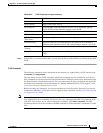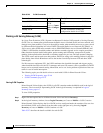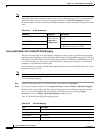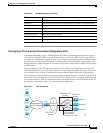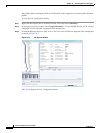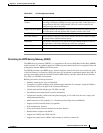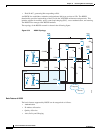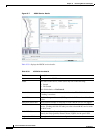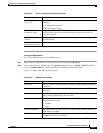
25-53
Cisco Prime Network 4.0 User Guide
OL-29343-01
Chapter 25 Monitoring Mobile Technologies
LTE Networks
Monitoring the HRPD Serving Gateway (HSGW)
The HRPD Serving Gateway (HSGW) is a component in the evolved High Rate Packet Data (eHRPD)
mobile network. It is an evolution option for CDMA operators that helps ensure converged mobility and
management between HRPD and LTE networks.
The HSGW terminates the eHRPD access network interface from the Evolved Access Network (eAN)
or Evolved Packet Core Function (ePCF) and routes UE-originated or terminated packet data traffic. It
provides interworking with the eAN/ePCF and the PDN Gateway (P-GW) within the Evolved Packet
Core (EPC) or LTE/SAE core network.
HSGW performs the following functions:
• Mobility anchoring for inter-eAN handoffs
• Transport level packet marking in the uplink and the downlink. For example, setting the DiffServ
Code Point, based on the QCI of the associated EPS bearer
• Uplink and downlink charging per UE, PDN, and QCI
• Downlink bearer binding based on policy information
• Uplink bearer binding verification with packet dropping of UL traffic that does not comply with
established uplink policy
• MAG functions for S2a mobility (i.e., Network-based mobility based on PMIPv6)
• Support for IPv4 and IPv6 address assignment
• EAP Authenticator function
• Policy enforcement functions defined for the Gxa interface
• Robust Header Compression (RoHC)
• Support for VSNCP and VSNP with UE
• Support for packet-based or HDLC-like framing on auxiliary connections
Allow APN in Called
Number
Indicates whether the APN name in Called number AVP is sent as part of the
Incoming-Call Request (ICRQ) message sent to the LNS. If this keyword is
not configured, then the Called number AVP will not be included in the
ICRQ message sent to the LNS>
Single UDP Port Mode Indicates whether the standard L2TP port 1701 is used as a source port for
all L2TP control and data packets that originate from the LAC node.
Peer LNS Address
Peer LNS Address The IP address of the peer LNS for the current LAC service, which is usually
in standard IPv4 dotted decimal notation.
Preference The priority of the peer LNS, which can be any number between 1 and 128.
This priority is used when multiple peer LNS are configured.
Crypto Map The name of crypto map that is configured for the selected context.
Description The description of the specified peer LNS.
Table 25-30 LAC Configuration Details
Field Description



